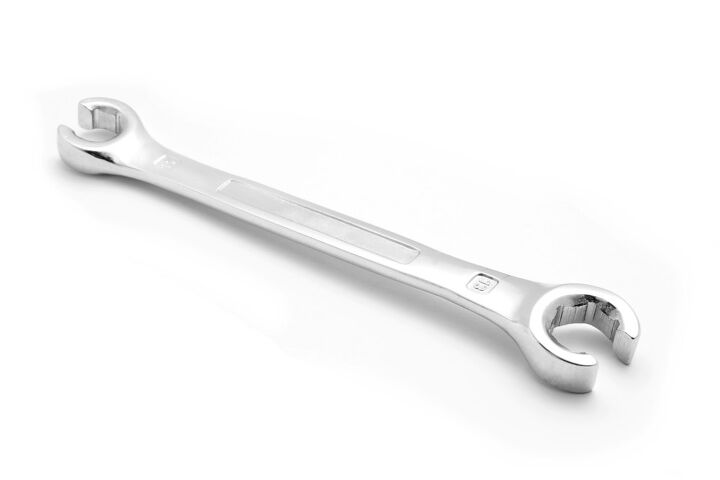How To Use A Crowfoot Wrench (In A Few Easy Steps)

A crowfoot wrench is a special wrench that is used when you need to work around obstacles. Unlike socket wrenches, this wrench fits on a nut or bolt’s side like a box wrench. A crowfoot wrench looks like a box wrench head, and it may be attached to a torque wrench for better performance.
Attach the crowfoot wrench head to a ratchet wrench. This allows you to turn the head to the angle you need. Additionally, you can attach extension bars to get a wide variety of ways to approach a nut or bolt. However, make sure that the extension is completely fastened so that it doesn’t slip off.
In this article, we will walk you through the correct steps to using a crowfoot wrench, as well as the different types of crowfoot wrenches. Furthermore, we discuss the advantages and disadvantages of using one.
Do You Need Handyman Services?
Get free, zero-commitment quotes from pro contractors near you.

Using A Crowfoot Wrench
Using a crowfoot wrench is easy. You just need to make sure you have a socket or torque wrench and follow these steps:
- Set the head. Place the crowfoot onto the square head of your torque or socket wrench. Ensure you have the right size wrench for your crowfoot. A 3/8 crowfoot needs a wrench with a 3/8 drive head.
- Slip the wrench onto the bolt. Rotate the crowfoot as needed to make it slip over the side of your bolt. Once you feel that it’s on the bolt properly, wiggle it to the right and left. If it won’t budge, then your wrench is secure on the bolt.
- Torque the bolt. Sometimes, this will take some power behind your torques. Don’t be worried if you can’t get the bolt to budge without working hard at turning it.
- Reset the crowfoot. With only a few exceptions, crowfoots need to be rotated back after every turn. You will need to follow steps one through three again for the next torque.
- Repeat these steps. You will need to repeat the steps above until your bolt is either off or fastened all the way.
Applications
Crowfoot wrenches are useful for both expanding a ratcheting wrench’s options. They also make an incredible tool for getting into tight places, such as fixing a garbage disposal. Here are some occasions when you may need to use them:
- A crowfoot wrench is useful when you want to access areas a wrench cannot. Place an extension bar on your ratchet wrench and use the crowfoot to slip between tight cracks. With a flexible extension bar, you can even remove fasteners around a tight angle.
- In some cramped locations, a socket wrench may have an obstruction that keeps it from slipping directly over a fastener. In this case, a crowfoot may be able to sit straight by it and still work.
Advantages Of A Crowfoot Wrench
Crowfoot wrenches make working in tight spaces much more manageable. Additionally, you will find the tool useful when working with soft materials. That is to say; you can apply a considerable amount of force without damage.
Combining crowfoot wrenches with a ratchet wrench may be easier than carrying a comparable wrench set.
Disadvantages Of Crowfoot Wrench
A crowfoot wrench is a useful tool for any Do it Yourselfer, but there can be a few disadvantages:
- A crowfoot wrench often needs to be repositioned every turn. Also, a crowfoot wrench requires a separate ratchet wrench.
- Though they can reach a lot of challenging locations, they can be very clumsy to use.
Different Types Of Crowfoot Wrenches
Like other wrenches, there are a few styles of crowfoot wrenches for different applications. These include:
Open End Crowfoots
These wrenches are the most common style of Crowfoot wrenches. These resemble a typical wrench. They easily fit onto the ends of connectors but lack a good grip, thus easily rounding the head.
Flare Crowfoots
These wrenches have a socket style head that mostly encloses the nut or bolt being torqued. This head gives an excellent grip, which prevents rounding the nut or bolt. These are frequently used when you are working on fluid lines such as plumbing or vehicle brake lines.
Ratcheting Crowfoots
These wrenches include both closed and open-end varieties. They help avoid some of the difficulty of resetting the position during use but often make it challenging to fit in tight spaces.
Adjustable Crowfoots
Adjustable crowfoots come in two varieties:
- Adjustable Spanner: An adjustable spanner crowfoot works just like an open-end variety, but with a screw assembly that allows for a range of size adjustments to the outer bar.
- Self-adjusting Crowfoots: Self-adjusting crowfoots contain a spring-loaded outer bar that tightly grips to the wrench’s inner surface. When slipped over a nut or bolt, the torque action further tightens the outer bolt, giving it a grip comparable to open-end wrenches.
Different Types Of Wrenches
There are several styles of wrenches that work well for home improvements or repairs. It helps to become familiar with them. Below, I list different wrenches and their intended purpose:
- Crowfoot Wrench: This wrench has no handle and attaches to a ratchet handle. This wrench works excellently in tight spaces.
- Open-end Wrench: This is an open-ended wrench. Use this wrench to access hard to reach nuts and bolts. But be careful; it’s somewhat prone to rounding the edges of nuts.
- Box Wrench: This wrench has a closed-loop on each end. Use it for square bolts or hexagonal bolts.
- Adjustable or Crescent Wrench: Crescent wrenches work well in many situations due to their adjustable size. The wrench contains a screw that opens or closes to change the size of the wrench’s crescent-shaped head.
- Pipe Wrench: This is a type of adjustable wrench. It is used mainly on pipes, as the name suggests making it useful for home repairs. It is shaped like the letter F instead of a crescent.
- Faucet Wrench: A faucet wrench has an angled head with a serrated jaw. It works great for repairs under sinks or toilets.
- Cone Wrench: Cone wrenches are wide, flat wrenches with tapered jaws. You could use this wrench for doing plumbing repairs in small bathrooms or narrow cabinets under the kitchen sink.
Crowfoot And Torque Wrenches
When using a crowfoot on a torque wrench, keep the crow’s foot at 90 degrees to handle the torque wrench. This keeps the torque difference to an insignificant level because you will not be increasing the lever arm length.
If you add a crowfoot but do not keep it at 90 degrees, you will need to correctly place the wrench to achieve the necessary torque. The formula for this is M1=M2xL1/L2. However, you could you an online calculator to obtain this value.
Should You Own A Set?
Crowfoot wrenches can be a significant investment. A good set can cost more than $200. Their applications can seem more useful if you consider what they can do better than combination wrenches.
They can save space over a set of combination wrenches, but they cost much more. They also are more unwieldy for the average person to use. The average user, especially one who does not work on engines, would probably be better served by a set of combination wrenches.
If you find yourself working on automobiles or repairing your riding lawnmower, you may find them useful. Also, if you use socket wrenches a lot, you may save some space by ditching combination wrenches for some crowfoots.
How Much Does A Crowfoot Wrench Set Cost?
Depending on the quality of the set, you can expect to pay between $60 and $140 when you purchase a crowfoot wrench set. However, some of the sets will cost even more than this because they come with all the parts that you need. For example, if you just need just a few of the heads of the wrench, it will cost on the lower end. If you’re buying a set that includes everything, you will pay between $120 to over $200.
Related Questions
What is the difference between a wrench and a spanner?
A spanner is a type of adjustable wrench. The spanner is different from a standard wrench because it works on many different sizes of nuts and bolts. It also has small teeth to help grip the nuts and bolts.
Why are there both metric and standard sets?
This is because many American fasteners use U.S. Customary Units, but fasteners from most parts of the world use metric units. Sometimes the same tool can fit both, but often not.
How do Crowfoot wrenches work?
The Crowfoot wrench is an open-ended or box end wrench, but it doesn’t have the handle or the shaft. This type of wrench is designed to fit on the side of a nut or bolt instead of the top. This allows them to work correctly when you need to work in a tight space.
Do You Need Handyman Services?
Get free, zero-commitment quotes from pro contractors near you.

Wrapping It Up
Using a crowfoot wrench is simple. They’re great for tight places, and they are designed to fit on the side of the bolt rather than on the top, like a socket. To use a crowfoot wrench, you simply need to ensure that it is on the bolt correctly and torque the bolt. Once you have turned it, you will need to lift it off the bolt and repeat. We hope this guide has been useful to you! Good luck.
Related Guides

I am a writer who enjoys working on home improvement projects. My husband was in the navy, so we moved frequently. This gave me many opportunities to fix up new places. In my spare time, I enjoy reading mysteries and hiking.
More by Lisa Borga

























![12 Washing Machine Brands to Avoid [with Recall Data]](https://cdn-fastly.upgradedhome.com/media/2023/07/31/9075781/12-washing-machine-brands-to-avoid-with-recall-data.jpg?size=350x220)

